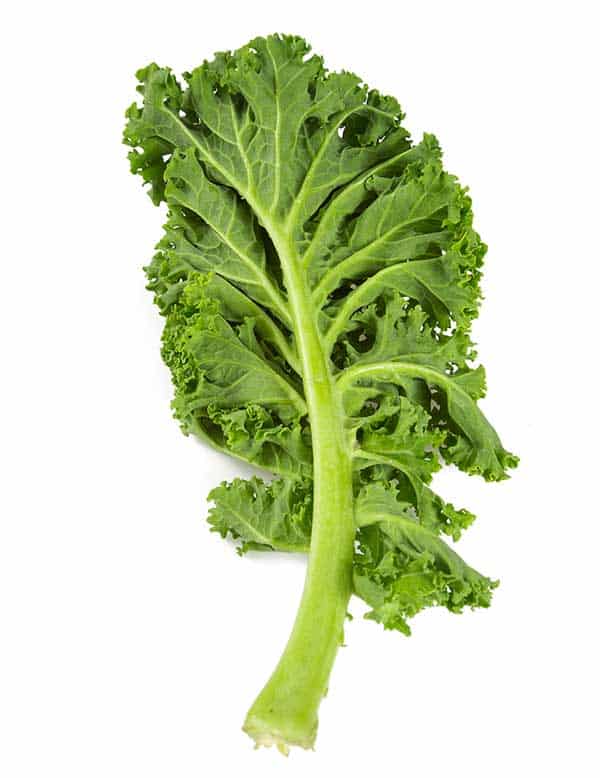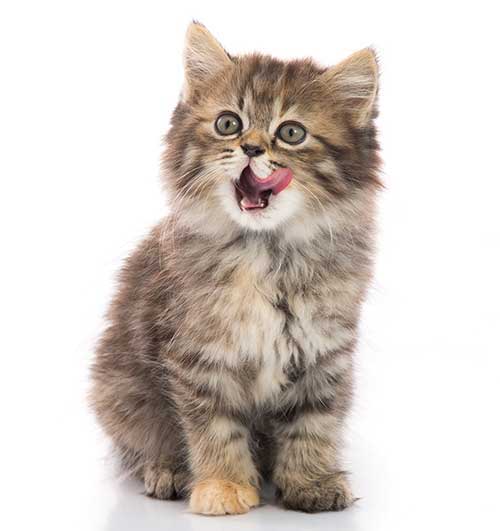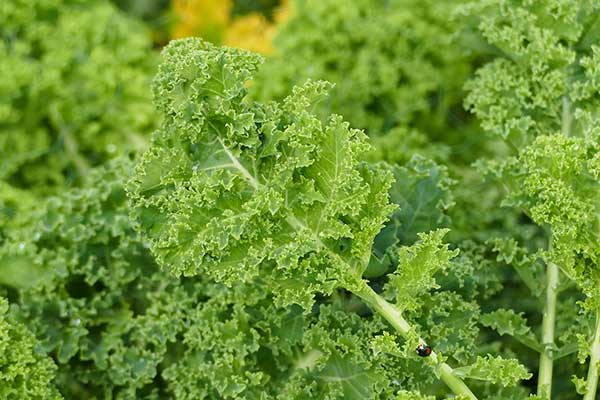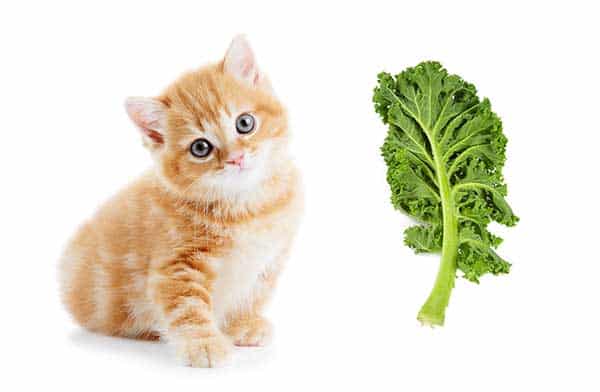It’s not unusual to come across cats begging for human foods. And neither is it unusual to come across cat owners freely offering people foods to their feline friends.
Many pet parents already understand that most human foods aren’t ideal for their furry, little friends.
However, in our vain attempts to appease our pets, we inadvertently find ourselves feeding them unsafe foods.
But let’s face it; cats can also be quite pesky when begging for human foods. Their constant meows can be so irritating that we find ourselves granting their favors. However, that still doesn’t make it right.
Before feeding your kitto any people food, you should establish the safety of that food for your feline friend. Now, let’s get back to our question – can cats eat kale?
Fortunately, cats can eat kales. While vets generally discourage plant-based foods for cats, kales happen to be one of the human foods that cats can safely eat. The vegetables are loaded with fiber, antioxidants, and other essential minerals that your cat can benefit from.
So, is kale safe for cats?
Yes, kale is perfectly safe for cats. However, like most greens, you should offer kales to your feline friend only as an occasional treat. Never substitute your cat’s regular diet of animal protein with kales or any other plant-based foods.
Read on as we dissect the topic further.
Table of Contents
Health Benefits of Kale
Is kale ok for cats to eat?
Yes, as we’ve just highlighted, kale is perfectly safe for cats.
The following are some of the health benefits that your cat can enjoy from snacking on kales occasionally;
1. Improvement of Digestion
Kales are loaded with dietary fiber, which includes both the soluble and insoluble fibers.
Dietary fiber plays three fundamental roles as far as improving the health of your cat’s digestive system is concerned.
First, the fiber nourishes your cat’s gut-friendly bacteria. Gut-friendly bacteria are the healthy bacteria that reside in an animal’s gut, which enhance digestion.
Secondly, the dietary fiber in kales might help to bulk your cat’s stool. By bulking your cat’s stool, the fiber eases gastrointestinal issues like indigestion, constipation, diarrhea, and bowel incontinence.
Lastly, dietary fiber creates a feeling of fullness for longer. By sprinkling kales over your cat’s regular diet, the cat will eat less but feel full for long. That way, you can manage the portions of food your cat eats, as a way of guarding against weight gain.
Dietary fibers have also been associated with improved functions of the heart and cardiovascular system. The fibers can remove “bad” cholesterol while adding “good” cholesterol to your cat’s bloodstream.
2. Prevention of Disease
Kale is loaded with powerful antioxidants, such as beta-carotene, Vitamin C, polyphenols, and various flavonoids like quercetin and kaempferol.
These antioxidants reduce the oxidative stress that may be caused by free radicals in your cat’s body.
In simpler terms, they prevent your cat from developing chronic conditions, such as arthritis, cancer, diabetes, etc.
The antioxidants in kale have also been shown to contain antiviral, antifungal, antibacterial, anti-depressant, and anti-inflammatory properties. That only goes to show how effective they can be in keeping various feline diseases at bay.
The following are other documented health benefits of kale;
✔ Can help to lower blood sugar and cholesterol levels,
✔ Can help with blood clotting and faster healing from wounds, thanks to its high content of vitamin K,
✔ Can improve your cat’s vision due to its abundance in vitamin A,
✔ Contains high levels of calcium and potassium, which can improve the health of your cat’s bones and cells, and
✔ Can lower the risks of macular degeneration and cataracts due to a high content of the antioxidants lutein and zeaxanthins.

Will Your Cat Benefit From All The Above Nutrients?
While kales boast a high nutritional profile, your cat may not necessarily benefit from the vegetable’s abundance in minerals and vitamins.
It’s important to remember that cats are obligate carnivores. As such, they derive almost all of their daily minerals and vitamins from a diet of animal protein.
Besides, the bodies of cats are designed to produce some of the minerals that they cannot obtain from their regular diet of meat.
For instance, humans may benefit from vitamin C that’s abundant in kales. But cats can produce this vitamin on their own.
It’s also worth noting that cats have a much shorter digestive system and their digestive system features a unique composition of digestive enzymes. Most importantly, all of a cat’s digestive enzymes are specialized for processing animal protein.
So, does that mean cats should not eat kales? Is kale toxic to cats?
Absolutely not. The consensus is that supplementing your cat’s diet with kales is a great idea. However, your feline friend will not benefit from the minerals and vitamins in kales the same way humans would.

Above all, you must realize that kale remains a plant-based food. As such, it should only appear in your cat’s diet as an occasional treat.
Now, you may be wondering, will kale hurt cats if they eat the vegetable more frequently than they should?
Yes, it will. Like most greens, kales can cause gastrointestinal distress if you overfeed it to your feline friend.
The high fiber content in the vegetable may have a laxative effect if consumed in large amounts, leading to diarrhea and dehydration.
Can I Give My Cat Kale Raw Or Cooked?
Now that kale appears to be a healthy green for cats, your next questions might be, can cats eat raw kale? And what of cooked kale, can cats eat cooked kale?
Cats can eat both raw and cooked kale. However, experts discourage raw kale for a couple of reasons.
First, raw kales may contain parasites and other pathogens that if ingested, might lead to gastrointestinal distress.
Secondly, raw kale may contain residues of harmful aerosols. If the pesticides and insecticides used in treating the vegetables were not certified as pet-safe, then ingesting raw kales can lead to toxicity.
Lastly, raw kales come with risks of choking, especially considering that cats do not take their time to chew their foods.

Still on choking, you must ensure you avoid giving your cat kale stems, roots, or other tough parts. So, if you were always wondering, “can cats eat raw kale stems”, we hope you’ve got your answer right there.
If you must offer raw kales to your kitto, ensure you wash the vegetables properly to eliminate harmful pathogens and toxic aerosol residues. Otherwise, you’re better off feeding your feline friend cooked kales.
When it comes to cooking, you must also remember that there are different methods involved. So, you could be wondering, how do I prepare kale for my cat?
The best way to prepare kale for your kitto is to boil or steam the vegetables. The goal is to kill all the parasites and destroy all the toxic chemicals while still keeping all the nutrients intact.
When it’s done, offer the vegetable to your cat plain, without adding salt or condiment. You can serve kales to your cat as a standalone meal or mix it into the cat’s regular diet.
But how much kale can I feed my cat?
As we’ve already mentioned, keep the portions low. Remember that this is by no means your cat’s staple food.
When starting off, you can experiment with small portions of the vegetable two to three times a week. Moving forward, you can adjust the portions as required.
Another common question cat owners often ask themselves is, can cats eat baked kale chips?
Baked kale chips is discouraged because most of the ingredients used in baking food are considered toxic to cats.
So, Can Cats Have Kales?
Yes, cats can safely eat kale. Just ensure you wash the vegetable thoroughly and boil or steam it before offering it to your cat. Most importantly, feed kales to your cat only as an occasional snack.
Checkout Our Favorite Cat Products
1. Best Online Course For Cat Parents
Our favorite: The Cat Language Bible (How to Finally Undrestand And Speak to Your Cat) – A new form of cat to human communication that many cat owners have dreamed about… but few have actually thought possible.
2. Best Vacuum to Tackle Pet Hair
Our favorite: Dyson Ball Animal 2 – Engineered for homes with pets. With features and tools that dig out dirt, hair and allergens everywhere your pet gets.
3. Best Immune Support For Cats
Our favorite: Tomlyn Immune Support – Best Supplement for Cats and Kittens.



